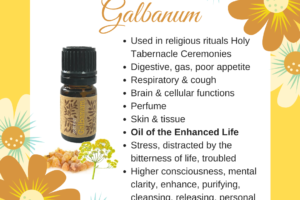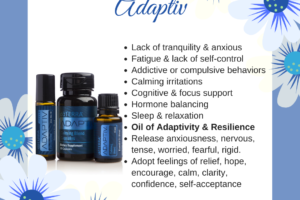View The Ylang Ylang Lesson Here


Enter for a chance to win a FREE Essential Oil Sample*
*Free samples available to anyone who has never tried doTERRA oils. (Limited to US and Canada)
Download a Ylang Ylang Essential Oil handout here.

Surprising benefits of Ylang Ylang
Do you find yourself thinking or saying, “If I don’t do it, who will?” Feeling joyless, overstressed and don’t know how to get out of it? I was like that most my life which lead to all sorts of health problems.
As a kid, I was super sensible and conscientious. As a wife and mother, I was work, work, work (cook, clean, teach the kids…) and not a lot of PLAY!
Ylang Ylang oil really helped me be more playful, happy, and heal from the fear of playing and being unproductive! This is a fantastic oil for those who ‘grew up too quickly’ or have lost their childlike carefree spirit.
Ylang Ylang essential oil is derived from the star-shaped flowers of the tropical Ylang Ylang tree. It is a popular oil in perfumes and in aromatherapy. Ylang Ylang is similar to Jasmine, in that it has been used for centuries in religious and wedding ceremonies.
Ylang Ylang flowers have been used to cover the beds of newly weds.1
In aromatherapy, Ylang Ylang is used to elevate moods. Ylang Ylang is frequently used in hair and skin products for its scent and nourishing and protective properties.
Ylang Ylang can be taken internally to provide antioxidant support.* . Ylang Ylang blends well with Bergamot, Geranium, Grapefruit, and Vetiver.
Ads.BODY
Skin: Add Ylang Ylang to your skin blends to soothe skin, calm skin from insect bites and support skin tissues in general.
Hormone Imbalance: Use Ylang Ylang all three ways: aromatically, topically and internally as needed to encourage the body to balance hormones.
Spring Sensual Diffuser Blend: Ylang Ylang 3 drops, Coriander 2 drops, Ginger 2 drops, Vetiver 1 drop, and Clary Sage 5 drops. Gently blend in glass container and add some drops to diffuser.2
Libido: Ylang Ylang is a fantastic oil to balance libido.
Diffuse for Good Night Sleep: 2 drops Ylang Ylang, 4 drops Roman Chamomile, and 4 drops Marjoram.3
Calming Blend for Diffusing: Ylang Ylang 10 drops, Clary Sage 10 drops, Geranium 12 drops, Roman Chamomile 12 drops, Lavender 18 drops, and Wild Orange 5 drops. Mix gently in glass container and then add to your diffuser product.4
Healthy Blood Pressure: Ylang Ylang 3 drops, Clary Sage 5 drops, Lavender 4 drops, and Marjoram 2 drops. Rub over heart and heart reflex points on left foot and left hand.5
Healthy Blood Pressure Massage Oil: Fractionated Coconut Oil 1 ounce, Ylang Ylang 4 drops, Lavender 4 drops, Melissa 1 drop, and Wild Orange 2 drops. Gently combine and apply to feet and legs.6
Stress-Smoothing Massage Oil: 2 ounces Fractionated Coconut Oil, Ylang Ylang 3 drops, Roman Chamomile 4 drops, White Fir 4 drops, Marjoram 3 drops, and Frankincense 3 drops. Blend gently and apply often.7
Nighttime Muscle Relief Oil Blend: 3 ounces Coconut Oil, Basil 6 drops, Roman Chamomile 4 drops, Marjoram 10 drops, Clary Sage 4 drops, Coriander 4 drops, and Cypress 6 drops. Gently blend and apply to sore muscles prior to sleep.8
Normal Hair Conditioning Treatment: Fractionated Coconut Oil 1 ounce, Ylang Ylang 2 drops, Lavender 5 drops, Roman Chamomile 3 drops, and Geranium 1 drop. Once or twice a month, and massage the mixture into your scalp and hair. Wrap your hair in a towel for one hour. Then use the dōTERRA shampoo and conditioner.9
Ylang Ylang helps stimulate hair growth. Click here to read about 3 big ways Ylang Ylang oil can be used to fight hair loss10 Click here for a Ylang Ylang and Maple Syrup Shampoo recipe.
MIND
Emotionally Ylang Ylang is the Oil of the Honoring the Inner Child. Whatever happened in your childhood, that isn’t resolved, needs to be dealt with sooner or later. Have you met people who are sometimes childish in someways but they can’t see it? This oil is for those people who had to ‘grow up too soon’ too. Each of us need to have a healthy carefree playful stage as we develop. If we are robbed of it (completely or partly) for some reason, we will need to revisit it sooner or later.
According to the Emotions & Essential Oils book, the negative emotions Ylang Ylang oil helps to release are as follows: joyless, overstressed, grief, sadness, loss of a loved one, and disconnected from inner child.
The positive properties we can incorporate are the following: freedom, playful, intuitive, heart healing, emotionally filled, joyful, and accepting.
I like to do a form of childhood healing I call Childhood Regression Technique. This is when you identify a pain or trauma in your childhood. You go back there in your mind and help the child exactly the way you know the child needs. If that child needed loving attention and acknowledgment then you give it to that child. This way, that inner child no longer hurts, cries out, and holds you back from being the balanced adult you are now. More information can be found in my Energy Balancing with Faith Course. If you need an Energy Healing Session click here.

An example is when I was 2 years old. We escaped Vietnam on a boat, and I had to step up and be sensible. Two years in the refugee camp followed that event. Growing up, I felt like I shouldn’t play so much and I should help out with my parents more. As I grew, I sought ways to help others and rarely took the time to simply play. Ylang Ylang was an overly sweet smell I couldn’t stand for a while.
I had to Acknowledged the 2, 3, and 4 year old girl and what she felt. She felt stuck, grief, sad and joyless. Then I Addressed the need. I allowed her to play and be carefree while someone else took over the burden. After that, I Appreciated the situation and made peace with it. I saw all the wonderful blessings that came with what I went through.
I needed to let myself balance the inner childhood joy and be more carefree. I learned that God and angels can take care of others, so I can let go a little. Can you see why our blood pressure and our hormones balances when we can satisfy the inner child?
Joyous Person Oil Blend: Fractionated Coconut Oil 4 teaspoons, Ylang Ylang 1 drop, Rose Oil 2 drops, Wild Orange 2 drops, Bergamot 3 drops, and White Fir or Siberian Fir 1 drop.11
Harmony Personal Blend: Fractionated Coconut Oil 4 teaspoons, Ylang Ylang 2 drops, Frankincense 4, Geranium 4 drops, and Vetiver 1 drop.12
Ads.SPIRIT
The root of the lack of joy is not because there isn’t joy around us, it is because we somehow don’t feel deserving of joy. We don’t feel deserving of joy because we’ve judged ourselves unworthy due to some subconscious measurement.
When you are conscious of this, then you can intentionally decided that you are loved and are enough for God. You no longer reject yourself and you soon find others love and accept you, too.
Self-Love and Self-Accepting Bath: Ylang Ylang 2 drops, Patchouli 2 drops, Cypress 2 drops, and Bergamot 4 drops. Add oils to Epsom salt and enjoy!
As you soak, repeat to yourself, “I fully love and accept myself.”
As a wife and mother, I parroted what has been said by many women of the ages. I find myself saying, “If I don’t do it, then it won’t get done! No one acknowledges how much I do.” Over time, I feel an immense pressure of responsibility weighing me down. I felt depressed, unappreciated, and used. My vision was clouded and that’s all I see. I felt that my husband and children haven’t appreciated me enough or helped as much as they should. In our mind we often remind ourselves to be mature, selfless and buck up. Over time, this overly-noble-martyr mentality isn’t going to float your boat forever. In reality, I have chosen to not see and appreciate how much I received in blessings because we haven’t loved or appreciated ourselves. Feeling more gratitude for yourself and what you have achieved will help you balance your life. You will teach others to love and appreciate you more. People will naturally step up and help out more.
What Are You Communicating?
Doing it all teaches our family two sad things. One is that we believe they are incapable and untrustworthy. The subconscious message we send out is that they can’t do it. We get frustrated further when they believe it and manifest that they can’t do it without our help.
The second thing is it makes them feel responsible for our happiness! We subconsciously guilt-trip our whole family into feeling they aren’t good enough to make us happy. Many times they try hard to please then eventually they give up because it’s a loosing battle. You can’t truly be happy by extrinsic forces. We have to choose to be happy and satisfy our inner child ourselves. No one can do it for us. The magical thing is when we satisfy our inner child we teach others to do the same.
Be Grateful
We all want our children to be happy right? The best way to do that is to be happy yourself and show that happiness by example. To be more happy, be more grateful. When you are grateful for things you are an open conduit for blessings. Work on receiving love and blessings like a child would from a parent.
First and foremost, be grateful for yourself. Love yourself like God loves you. You are a person of great potential. Keep smelling Ylang Ylang to help you re-wire your brain neurons. Soon you will see you have more friends and people are kinder and nicer to you.

Allow God and Angels to do their job
In reality, we are not alone. Let go slowly and expect others are capable and able to work with you. Smell Ylang Ylang and picture invisible helpers around you. Also, use probiotics to help you learn to work synergistically with others.
*These statements have not been evaluated by the Food and Drug Administration. This product is not intended to diagnose, treat, cure, or prevent any disease.
- Modern Essential Book
- Personal notes from Dr. Sue Lawton
- Personal notes from Dr. Sue Lawton
- Personal notes from Dr. Sue Lawton
- Personal notes from Dr. Sue Lawton
- Personal notes from Dr. Sue Lawton
- Personal notes from Dr. Sue Lawton
- Personal notes from Dr. Sue Lawton
- Personal notes from Dr. Sue Lawton
- https://www.hairlossrevolution.com/using-ylang-ylang-oil-to-re-grow-hair/
- Personal notes from Dr. Sue Lawton
- Personal notes from Dr. Sue Lawton
Table of Contents




































